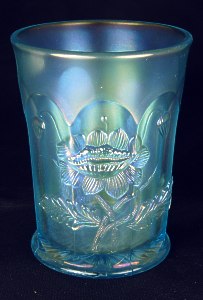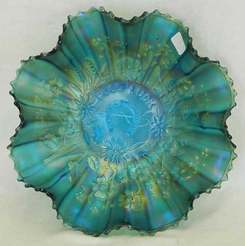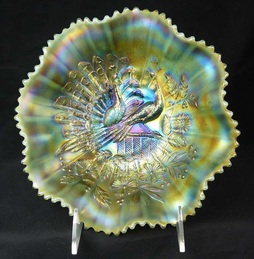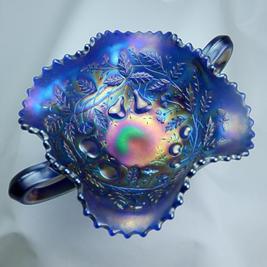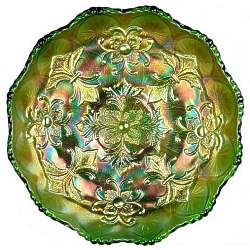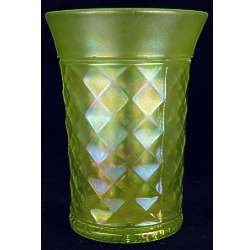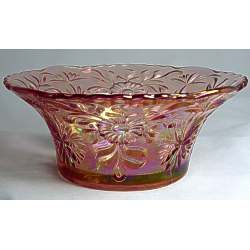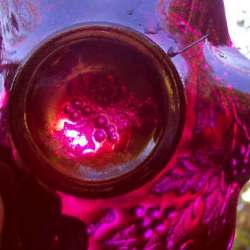Carnival Glass Colours - Blue
Coloured glass is produced by adding various compounds (mainly metal oxides) to the glass batch. The two main colouring agents that were used to make blue were Cobalt hence cobalt blue, which is a deep Royal blue, and Chromium, which made a lighter, slightly greenish blue, such as celeste blue.
|
The photo on the right was taken by Stephen Thistlewood. It shows, clockwise from the back left: Fenton Chrysanthemum bowl in powder blue with a bronzey iridescence Jain Hand vase, small size, in Jain blue Northwood Fruits and Flowers footed bonbon in aqua opal with a butterscotch iridescence Northwood Singing Birds mug in aqua opal, with a more pastel iridescence Fenton Peacock and Urn bowl in Persian blue, with a butterscotch or bronzey iridescence Fenton Peacock and Urn comport in powder blue with a marigold iridescence. |
In its simplest form, blue is an easy colour to recognise – but it can also be very controversial, because blue merges into green on the spectrum, and in the overlapping area are a myriad of shades that are very difficult to distinguish, even when they are seen side-by-side. Seen separately, they can lead to much debate over what the colour actually is.
A display of blue tumblers.
From the left: Peacock at the Fountain, ice blue (Northwood); Oriental Poppy, ice blue (Northwood);
Orange Tree *, celeste blue (Fenton) and Grape Arbor, sapphire (Northwood).
From the left: Peacock at the Fountain, ice blue (Northwood); Oriental Poppy, ice blue (Northwood);
Orange Tree *, celeste blue (Fenton) and Grape Arbor, sapphire (Northwood).
* Courtesy of the late Bob Smith's Tumbler Museum.
This is a list of the blue Carnival shades, from the lightest up to darkest (some of them are also known with opal edges).
Ice blue – palest of all. Also known with a touch of opal (ice blue opal). Some controversies over ice blue (see Controversies)
Powder blue – often has a marigold or bronzey iridescence, and can also have a pastel iridescence. Debate centres on whether it must have one or the other type of iridescence. Also known with a touch of opal (powder blue opal)
Jain blue – some factories have used recycled glass, adding lots of cullet to the batch. This is quite possibly how the distinctive light blue known as Jain blue was produced in India.
Persian blue – iridised blue moonstone – a translucent, see through, but pale, milky blue colour. The iridescence can vary on Persian blue, as it may be pastel or butterscotch / bronze (see further information on semi-opaque colours).
Aqua and aqua opal – light blue/green, sometimes with an opal edge. The iridescence can vary from a delicate pastel to rich butterscotch.
Celeste blue – a light sky blue with a pastel, stretchy (onion skin) iridescence. In our opinion it categorically should not have a marigold iridescence, but there are some collectors who perceive it that way. Fenton and Dugan/Diamond made this colour, and a small amount from Northwood (mainly Stretch glass). Interestingly, celeste blue Carnival Glass has been found in England more than anywhere else - we explain with the connection to Charles Pratt, here.
Sapphire blue – similar to celeste, perhaps a touch darker – can have a pastel iridescence or a marigold/bronzey iridescence or even a green iridescence. But it is neither frosty nor stretchy, as celeste is. Sapphire blue is predominantly a Northwood colour. Some collectors say it may be found with an opal edge
Renninger blue - a grey-turquoise blue colour that is predominantly from Northwood and is often stippled with a thin marie (collar base). May have a greenish tone to the iridescence.
Iridised blue milk glass – dense and opaque – you can’t see through it. It is actually light blue milk glass with iridescence (usually marigold) - see previous page on opaque colours.
(Standard) Blue – the mid range, balanced colour that is not deep or intense. Sometimes found with an opal edge (blue opal)
Cobalt blue – a velvety, rich and intense blue (also known with a hint of opal as well - cobalt blue opal) . Note electric blue - a vivid iridescent effect - is often found on cobalt blue base glass.
Blue slag, called Sorbini – blue glass with streaks of white glass giving the appearance of marble. The name originated with Sowerby in the late 1800s: they called their blue/white malachite glass by the name Sorbini.
Teal – a blue-green shade. It is a tricky colour to pin down as it is the "cross-over"between blues and greens.
A Carnival glass display that we organised (below, left picture) shows a selection of Four Flower Variant bowls and plates in varying shades of green, from teal to a "bottle green" colour. On the right is a Four Flowers Variant 9.5" plate in teal for comparison.
Click on any image to look at more colours


